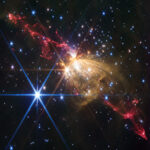Neutrinos are extra hard to spot. These subatomic particles have almost no mass, making them especially difficult to find and study. If only neutrino detectors could grow on trees, thought Steven Prohira. Or — could they? In fact, he now proposes, forests might indeed be used one day to spot ultra-high-energy neutrinos.
Trees could act as natural antennas, he suggests. Pohira is a physicist at the University of Kansas in Lawrence. He studies subatomic particles from space, including the neutrinos that shower down on Earth.
Trees might pick up radio waves produced by certain types of neutrino interactions. He proposed this idea in a paper submitted January 25 at arXiv.org. (Papers on this site have not yet been vetted by other scientists.)
Scientists Say: Radio Waves
“It is a very exciting idea,” says Amy Connolly. She’s a physicist at Ohio State University in Columbus. She did not take part in the new work. “This could be … a natural solution that may have been sitting there under our noses,” she says.
Neutrinos typically demand large, sensitive detectors. That’s especially true for detectors designed to snag the rarest, highest-energy neutrinos from space. Building such enormous detectors from scratch is a major hurdle.
But physicists are known for building inventive detectors in natural settings. Take the IceCube Neutrino Observatory. It searches for neutrinos using a cubic kilometer (0.24 cubic mile) of Antarctic ice. Then there’s the Cubic Kilometre Neutrino Telescope, or KM3NeT. Now being built, it will search for neutrinos interacting in the Mediterranean Sea.
These detectors are huge. Their large volumes make it possible to catch rare, high-energy neutrinos.
Neutrinos could help solve one of the biggest mysteries of the universe.
Trees as antennas
Tau is a special type of neutrino that scientists hope to spot. Like other neutrinos, it can travel through the atmosphere and ground. Occasionally, one may interact with matter inside Earth. When it does, it can make a particle called a tau lepton.
That tau lepton can escape the ground and enter Earth’s atmosphere. There, its decay can produce a shower of charged particles, which make radio waves. Scientists have proposed ways to detect those radio waves.
One is the enormous GRAND experiment. This detector would use a total of 200,000 antennas (spread across 20 arrays around the world). Building such a detector would be a huge undertaking.
“It dawned on me that it’d be cool if the antennas were already there,” says Prohira. He thought about forests. Their trees can pick up radio waves. Scientists would just need to wire up the trees to detect when they encountered the radio signals. One technique: Nail a wire into each tree or wrapped in a coil around its trunk. Connecting those wires to electronics could read out the radio waves.
It’s not yet clear if this will work, Prohira notes. Many questions still need to be answered. Neutrino detectors of this type use very high frequency radio waves. So scientists would need to study how well trees pick up waves in this range. Plus, traditional radio antennas can be built to precise specs. Trees, of course, can’t be.
So it’s harder to know how trees will respond to different types of radio signals. For instance, radio waves can be polarized. That refers to how their wiggles are oriented. It’s not clear how trees would respond to that polarization.
Trees’ leaves could also affect how they pick up radio signals. If true, this might affect radio-wave detection late in the year by trees that shed their leaves in fall. So that needs to be studied.
The tree-as-antenna idea is inspiring, says Eric Oberla. But it’s not clear whether replacing “manufactured antennas with trees will solve more problems than it might create,” he adds. This type of detector would raise a lot of design challenges, he says. Oberla is a physicist at the University of Chicago in Illinois.
Another crucial question: How might being as a detector affect the forest itself. “Such a detector must be built in harmony with, and with respect for, nature,” Prohira writes in the paper. “Otherwise, this idea is not worth trying.”
Do you have a science question? We can help!
Submit your question here, and we might answer it an upcoming issue of Science News Explores





Leave a Reply
You must be logged in to post a comment.